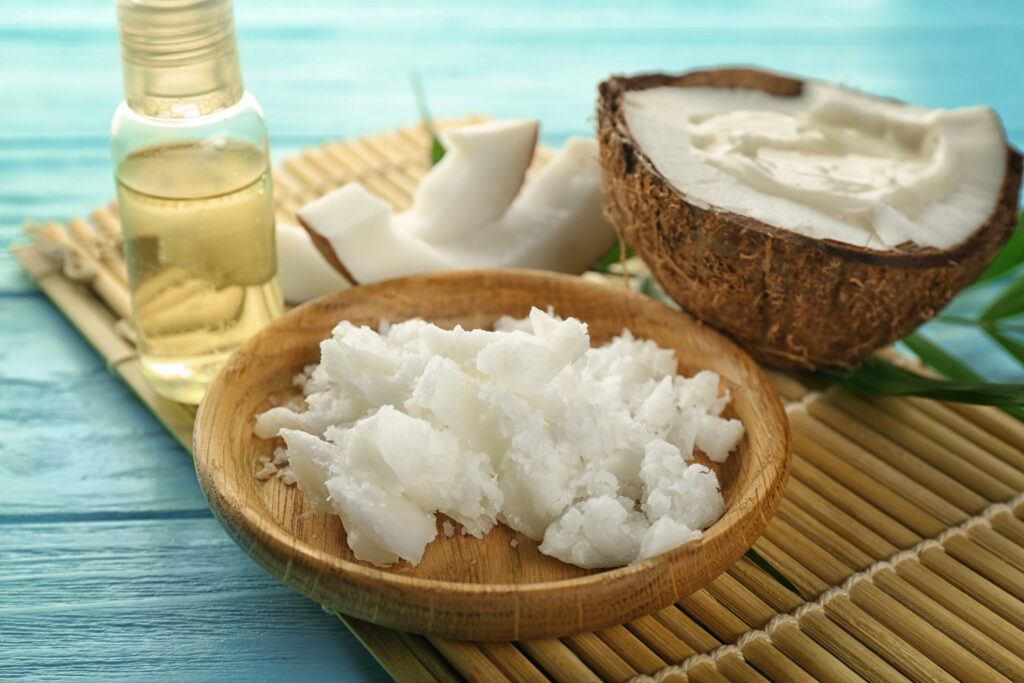Hey there!
Today we are exploring a subject which you may have or have not heard about and it has to do with oil pulling…..Coconut oil pulling specifically.
Coconut oil pulling is an age-old practice rooted in Ayurvedic medicine and it has long gained interest in oral health and wellness circles due to its potential benefits for dental health.
This regimen involves swishing a spoonful of coconut oil in one’s mouth for twenty minutes daily and is believed to enhance oral hygiene and general well-being.
There is research indicating that it can prevent plaque build-up and relieve symptoms of gingivitis, making it an excellent additional preventive measure for oral health.
However, it’s crucial to note that this practice does not substitute routine brushing and flossing.
This article provides an in-depth exploration of coconut oil pulling, its origins, alleged benefits, scientific substantiation, and its role in daily dental care.

Key Takeaways
- Coconut oil pulling is an ancient practice rooted in Ayurvedic medicine that has gained renewed interest for its potential oral health benefits.
- Coconut oil pulling can significantly reduce harmful bacteria in the mouth, maintain healthy gums, reduce inflammation, and inhibit plaque buildup and tooth decay.
- Oil pulling should not replace traditional oral hygiene practices such as brushing and flossing, but can be a supplement to an oral hygiene routine.
- It is important to consult with a dental professional before starting coconut oil pulling to assess individual oral health needs and ensure safe and effective practices.
Understanding Coconut Oil Pulling
A significant number of people are now embracing coconut oil pulling, an age-old Indian practice, which involves swishing extra-virgin coconut oil in the mouth as a form of reducing harmful bacteria. This method, primarily aimed at improving oral health, has gained traction due to its simplicity and the benefits of oil pulling, which extend beyond mere oral hygiene.
In addition to reducing bacteria, coconut oil pulling is believed to help with oral health in several other ways. It can help reduce plaque and gingivitis, whiten teeth, and freshen breath. Some people also believe that it can help with other systemic health issues, though more research is needed to confirm these claims.
To practice coconut oil pulling, a person can take about a tablespoon of extra-virgin coconut oil and swish it around in their mouth for 15-20 minutes. It is important to not swallow the oil, as it is believed to be full of bacteria and toxins that have been pulled from the mouth. After the time is up, it should be spit out into the trash rather than the sink, as it can solidify and clog pipes over time.
While coconut oil pulling can be beneficial for oral health, it is important to note that it should not replace regular brushing and flossing. It can be used as a supplementary practice to help improve oral health, but it is not a replacement for basic oral hygiene.
As with any new health practice, it is important to consult with a dentist or healthcare professional before starting coconut oil pulling, especially for those with existing oral health issues. Overall, coconut oil pulling can be an effective and natural way to improve oral health and hygiene.
The benefits of oil pulling are manifold. Primarily, it helps reduce inflammation of the gums, characterized by gingivitis. Additionally, it can significantly reduce oral malodor, offering an alternative solution to bad breath. However, it should be noted that coconut oil pulling is a supplement, not a substitute, for regular dental hygiene practices. Therefore, while it can improve dental hygiene, it should be used in conjunction with traditional oral care methods.
Proven Benefits Of Oil Pulling With Coconut Oil For Dental And Oral Health
Numerous scientific studies have highlighted several proven benefits of coconut oil pulling for oral health. This ancient practice, when incorporated into a regular dental hygiene routine, can markedly improve oral health.
Firstly, oil pulling with coconut oil significantly reduces harmful bacteria in the mouth. The primary culprit, Streptococcus mutans, is a key player in plaque buildup and tooth decay. Regular oil pulling can inhibit the growth of this bacteria, keeping your mouth cleaner and healthier.
Secondly, coconut oil pulling rivals the effectiveness of standard chlorhexidine mouthwash in maintaining healthy gums and reducing inflammation. This can help in preventing the onset of periodontal diseases, thus ensuring optimal dental hygiene and oral health.
Lastly, there is more evidence to indicate that oil pulling may help reduce bad breath, a condition medically known as halitosis. Bad breath can often be a sign of underlying dental issues. By helping to combat this, coconut oil pulling contributes to improved oral health.

Step-by-Step Coconut Oil Pulling Guide
Beginning your journey with coconut oil pulling involves understanding and following a simple, step-by-step oil-pulling guide, ensuring its correct application for optimal oral health benefits.
This guide will help you to safely and effectively perform coconut oil pulling for teeth, an Ayurvedic practice that can enhance oral hygiene when used in conjunction with regular brushing and flossing. The process involves swishing the oil around your mouth, and it’s important to carry out each step correctly.
Here is a clear, concise table outlining the steps:
| Steps | Description |
|---|---|
| 1 | Start with a tablespoon of coconut oil |
| 2 | Swish the oil around your mouth for 15-20 minutes |
| 3 | Spit the oil into a trash can |
| 4 | Rinse your mouth with warm water |
| 5 | Brush your teeth as usual |
Potential Risks and Precautions
Although coconut oil pulling can provide certain advantages for oral health if done properly, it is important to take into account various possible dangers and precautions. This traditional treatment may assist in decreasing harmful bacteria in the oral cavity, but it should not be a substitute for regular oral hygiene habits like brushing and flossing.
The act of swishing oil in the mouth for extended periods can lead to accidental ingestion, potentially causing digestive discomfort.
Some individuals may experience allergic reactions to coconut oil, leading to oral discomfort or other adverse symptoms.
People with certain dental conditions might find this practice uncomfortable or exacerbating their condition, hence it is crucial to consult a dental professional before starting coconut oil pulling for teeth.
Comparing Oil Pulling and Traditional Methods
The comparison between coconut oil pulling and traditional oral hygiene methods reveals interesting insights into their effectiveness and applicability. Both practices aim to promote dental hygiene and oral health, but their approaches and effects vary.
One of the key differences lies in the effect of oil pulling versus brushing and flossing. Oil pulling works by attracting and dissolving the bacteria and plaque in the mouth, while brushing and flossing manually remove these.
| Method | Effectiveness |
|---|---|
| Oil Pulling | Reduces markers of gingivitis and bad breath, inhibits plaque formation |
| Brushing and Flossing | Removes plaque and food particles mechanically, controls bad breath |
While coconut oil pulling for teeth cannot replace brushing and flossing, it can serve as an adjunctive oral hygiene practice. More research is needed to further understand the comparative benefits and potential drawbacks.
Testimonials and User Experiences
An examination of various testimonials and user experiences reveals a diverse range of outcomes and perspectives on the practice of coconut oil pulling for teeth. Several people swear by this method, citing improvement in their oral health, while others remain skeptical.
- Reduced Plaque and Improved Oral Hygiene: Many users have reported a noticeable reduction in plaque after incorporating coconut oil pulling into their routine. This has been linked to fresher breath and healthier gums.
- Prevention of Tooth Decay and Gum Disease: Numerous testimonials suggest that regular practice of oil pulling has helped them stave off tooth decay and gum disease.
- Potential Teeth Whitening Effects: Some users have observed potential teeth whitening effects after incorporating coconut oil pulling into their dental care routine, although this is not scientifically proven.
It is vital to remember, however, that oil pulling is not a substitute for brushing your teeth and maintaining proper dental hygiene. It can supplement your oral health regimen, but it must not replace the foundational practices of brushing and flossing.
Lastly, individual results may vary, and it’s always recommended to consult with a dental professional before starting any new oral health routine.
Further Research and Studies
Significant advancements in the field of dentistry and oral health have sparked an increased interest in further research and studies on the effectiveness of coconut oil pulling for teeth. While some preliminary studies have indicated that coconut oil pulling may have antimicrobial properties and potential benefits for oral health, high-quality evidence is still lacking.
Further research is necessary to substantiate these claims and determine the extent of its potential benefits. Future clinical trials should focus on rigorous design and execution to provide sound, high-quality evidence. Moreover, studies should encompass larger sample sizes and multiple centers for comprehensive results.
The following table summarizes some avenues for future research:
| Areas for Further Research | Why It Is Needed |
|---|---|
| Comparison with other oils | To determine if coconut oil has superior benefits |
| Level of effectiveness | To establish how beneficial oil pulling is for oral health |
| Rigorous clinical trials | To provide high-quality evidence |
| Large sample sizes, multiple centers | To ensure broad, comprehensive results |
| Understanding the full extent of effectiveness | To determine if oil pulling can be recommended as a regular practice |
Frequently Asked Questions
Is Coconut Oil Pulling Good for Teeth?
Coconut oil pulling can contribute to improved oral health by reducing harmful bacteria and inflammation in the mouth. However, it should supplement, not replace, regular brushing and flossing as part of a comprehensive dental hygiene routine.
How Long Should You Pull Your Teeth With Coconut Oil?
For optimal results, one should perform oil pulling with coconut oil for approximately 15-20 minutes daily. This duration allows the oil to effectively reduce harmful bacteria, plaque, and gingivitis in the mouth.
Do You Brush Your Teeth Before or After Oil Pulling?
After practicing oil pulling, it’s advisable to brush your teeth. This acts as a final sweep, ensuring all lingering oil residues are thoroughly removed, thus maintaining optimal oral hygiene. Regular dental care shouldn’t be replaced by oil pulling.
Are There Negatives to Oil Pulling?
Potential negatives of oil pulling may include an upset stomach, diarrhea, or lipid pneumonia if accidentally inhaled. Additionally, it should not replace traditional oral hygiene practices such as brushing and flossing.
How Does Coconut Oil Pulling Help with Bad Breath?
Coconut oil pulling is a fast bad breath solution that can help eliminate bacteria in the mouth, reducing the odor that contributes to bad breath. Swishing coconut oil in the mouth for 10-15 minutes can remove toxins and promote better oral hygiene, leading to fresher breath.
Conclusion
In essence, coconut oil pulling is a practice deeply rooted in Ayurvedic traditions. It offers a promising avenue for enhancing oral health, potentially mitigating plaque and gingivitis. Nevertheless, it remains a supplementary measure, not a substitute for conventional oral hygiene practices.
As it gains traction globally, continuous research is warranted to fully elucidate its benefits and potential drawbacks. It is this holistic understanding that will guide its judicious application as part of a comprehensive dental hygiene regimen.
